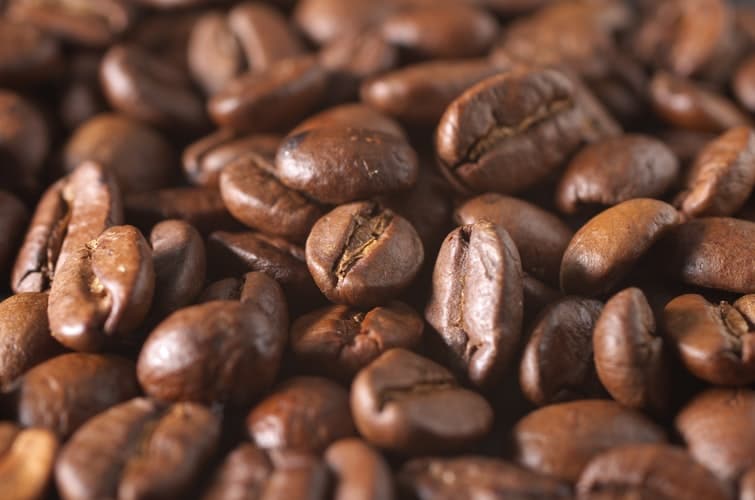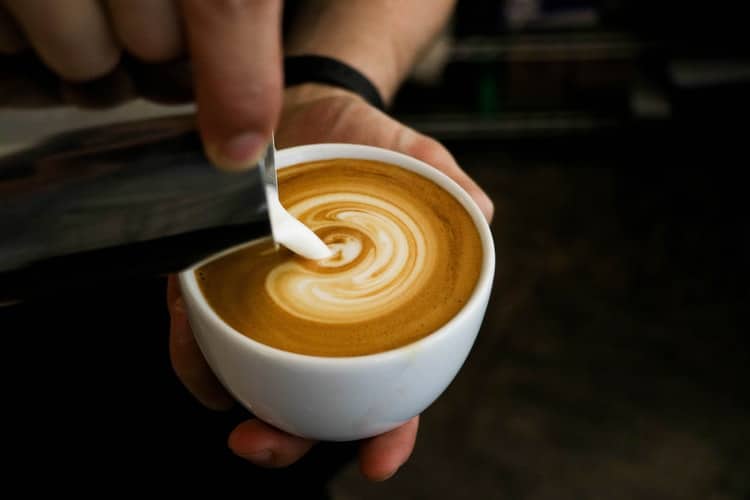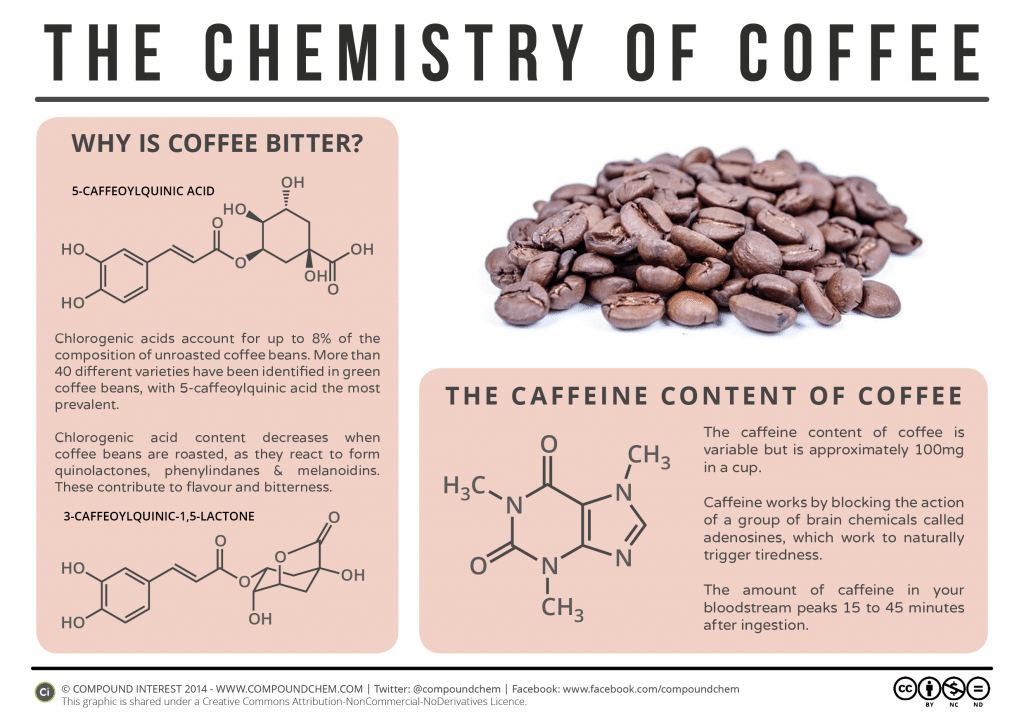Despite many different drinks, most of us still prefer coffee. But why do we love it so much? Undoubtedly for the pleasant aroma, its rich coffee taste and, of course, for the vitality that it gives us throughout the day.
What is it about coffee that gives us such cheerfulness? All thanks to the natural stimulant caffeine, or, as some call it, guanine, which is found in the beans of the coffee tree. I want to say right away that this substance will not be useful for everyone. Two cups contain approximately 155 mg of caffeine, but do you know how much caffeine in a coffee bean?
How much caffeine is in Arabica beans and Robusta?

If you heard from someone that Robusta beans have more caffeine than Arabica beans, then you should know that this is true.
Robusta beans contain about 2.2-2.7% caffeine, and Arabica beans – 1.2-1.5%.
Thanks to the higher caffeine content, the Robusta plant is less susceptible to pests and diseases. Not all pests like the bitter taste and diseases cannot tolerate its antimicrobial properties.
Also, it gives a bitter taste already in the brewed drink. A cup of boiled Robusta contains about twice as much caffeine as a cup of Arabica.
How much caffeine is in raw beans?
Raw coffee in beans has a different profile of caffeine than roasted beans because the roasting process draws out part of the caffeine. The longer the beans are roasted, the more caffeine is lost. Let’s look at the amount of caffeine in a bean before roasting it.
In many European countries, two types of beans are widely used for caffeine consumption: Arabica and Robusta. Arabica beans are considered to be of much higher quality and are used more often than Robusta beans.
At the expense of caffeine content.
Raw Arabica beans contain approximately 1.2% caffeine, while Robusta beans in raw form contain 2.2%.
How much caffeine is in roasted beans?
Like raw beans, Arabica beans contain less caffeine than Robusta beans. The same applies to the amount of caffeine in the roasted bean. After roasting, Arabica beans contain about half of the caffeine as Robusta beans. The amount of caffeine in one Arabica bean is about six milligrams. Robusta beans contain 10 milligrams of caffeine after roasting.
Caffeine content may also depend on the level of roast. As mentioned earlier, the more roasted the beans, the less caffeine is stored. In one light-roasted bean, there is 15-20% more caffeine than in dark roast beans. It may sound like a big enough number to make a difference, but for a small bean, it isn’t that much. The difference in caffeine levels between roasted compared to whole cups of coffee is small but still interesting.
What is caffeine?
Caffeine is a natural stimulant most commonly found in tea, coffee, and cocoa plants. It works by stimulating the brain and central nervous system, helping you stay alert and preventing fatigue.
Historians trace the first brewed tea back to 2737 BC. Coffee was reportedly discovered many years later by an Ethiopian shepherd who noticed the extra energy it was giving to his goats.
Caffeinated soft drinks appeared on the market in the late 1800s, and energy drinks soon followed.
Currently, 80% of the world’s population consumes caffeinated products every day, and this figure is rising to 90% for adults in North America.
SUMMARY: caffeine is a natural stimulant consumed worldwide. Most people get it from coffee, tea, soft drinks, energy drinks or chocolate.
How much caffeine do you have in a cup?

How much caffeine in a cup of coffee from a Cezve Turk?
A liter of such a drink prepared classically contains about 380 – 650 mg of the invigorating liquid. It turns out that the permissible dose of such coffee is not more than 5 – 7 small cups.
How much caffeine is there in a coffee machine?
Espresso is one of the strongest varieties of this drink and many drink it in the morning to cheer up. It has the highest caffeine content – a total of 1700 to 2250 mg per 1 liter. And if we are talking about ristretto, then it has even more caffeine. Such drinks should not be consumed in very high quantities by those who are not prone to hypertension and do not have other health problems. It is better to limit yourself to 1 – 2 cups per day, taking significant breaks between using high amounts of espresso to reduce the burden on the body.
Espresso drinks
Many popular coffee drinks are made from espresso mixed with different types and quantities of milk. These include latte, cappuccino, macchiato, and americano. Since milk does not contain any additional caffeine, these drinks contain the same amount of caffeine as espresso. One (small) contains on average about 63 mg of caffeine, and double (large) – about 125 mg.
How much caffeine is there in instant coffee?
Inveterate coffee lovers tend to claim that freeze-dried powder has nothing to do with real coffee. Perhaps, as far as taste is concerned, instant coffee differs from the original. However, in terms of caffeine content, this statement is not entirely true. If you didn’t know how much caffeine is in instant coffee, remember – 310 – 480 mg of an invigorating substance per liter of such a drink. However, much depends on how much your mug is and how many spoons you take per serving.
How much caffeine is contained in decaffeinated coffee?
Do not be surprised – such a drink can not contain an invigorating component at all. If you choose decaffeinated coffee, then it contains caffeine in an amount of about 2.5% of the usual dose – about 12 – 13.4 mg per serving. Modern technologies make this drink safer for hypertensive patients, but it does not lose its taste.
How much caffeine is in green coffee?
This healthy product is still coffee. Accordingly, it also has caffeine, however, in smaller quantities. It should be remembered that the amount of invigorating substance in the grains increases during the roasting process. From this, it follows that how much caffeine is in green coffee depends on the degree of roasting.
How much caffeine is found in coffee with milk?
It is believed that when milk is added, the amount of caffeine in coffee decreases. Of course, this is not so. However, there is good news for coffee lovers. The effect of caffeine on the body with the addition of milk will be more gentle. It turns out that how much caffeine is contained in coffee with milk depends on its roasting, and not on the availability of milk.
How much Caffeine Per Day is Safe to Use?
Caffeine intake is generally considered safe.
However, remember that it is addictive, and some people’s genes make them more sensitive to it.
Some side effects associated with excessive consumption include anxiety, restlessness, tremors, irregular heartbeats, and trouble sleeping.
Too much caffeine can also cause headaches, migraines, and high blood pressure in some people.
Also, it can easily cross the placenta, which may increase the risk of miscarriage or low birth weight. Pregnant women should limit their intake.
Finally, it is worth noting that caffeine may interact with certain medications.
Individuals taking Zanaflex muscle relaxant or Luvex antidepressant should avoid caffeine, as these drugs can enhance its effect.
SUMMARY:
Caffeine can have negative side effects in some people, including anxiety, restlessness, and trouble sleeping.
Recommended dosage
The US Department of Agriculture (USDA) and the European Food Safety Authority (EFSA) consider 400 mg of caffeine to be consumed daily. This is 2–4 cups per day.
It is worth noting that with an overdose of 500 mg of caffeine, overdose with a fatal outcome has previously been reported.
Therefore, it is recommended to limit the amount of caffeine consumed at a time to 200 mg per dose.
Finally, according to the American College of Obstetricians and Gynecologists, pregnant women should limit the daily dose to 200 mg.
Chemical composition of coffee beans

Fats
In coffee beans, the fat content (from coffee oil) is subject to significant interspecific and intraspecific fluctuations. The lowest fat content is in Indian varieties. A distinctive feature of oil is the high content of dieter foam esters. Unsaturated fatty acids in coffee oil account for more than half – 51.9–57.3%, of which linoleic acid predominates (37.2–45.6%).
In coffee oil from beans of different types and varieties, the qualitative composition of fatty acids is almost identical. When storing raw coffee, the acid and peroxide amounts of fat slightly increase, which indicates a slow down of intracellular hydrolytic and oxidative processes.
Carbohydrates
Carbohydrates have a significant impact on the taste of the drink. The main offender is sugar, which is the base of most flavorings. Carbohydrates in mixed coffee are sugars, heteropolysaccharides, and fiber.
Sugar
Sugar is represented by glucose, fructose, galactose, and sucrose, which make up approximately 28% of water-soluble substances. Raw beans in Arabian varieties contain 8.2–8.3% monosaccharides, while 3.3–4.1% are present in Robusta. During the storage of raw coffee, the sugar content decreases slightly.
Heteropolysaccharides
Heteropolysaccharides are represented by Galatians, mannans, glucans, and Arabians. The polysaccharides of green beans include arabinose – 1.8%, galactose – 9.3%, mannose – 20.8%, glucose – 6.8%. At the same time, in roasted beans and the extract, these sugars and heteropoly polysaccharides are present in trace amounts (0.3% glucose, 0.16-0.05% fructose, 0-0.26% mannose and 0.02-0.3% – glucose and sucrose). Thus, during high-temperature processing and under the influence of high pressure (up to 2.5 MPa), cracking processes of destruction of carbohydrates occur in coffee beans.
Cellulose
Fiber, one-third of the dry matter of best coffee beans, forms the hardness and density of the beans. Not allowing to fall apart and increase in volume during roasting, fiber allows you to get a fragrant product. Moreover, it is one of the most stable components, and individual types and varieties of beans practically do not differ in fiber content.
Tannins
Tannins cause astringency of a coffee drink. There is a direct correlation between the content of tannins and chlorogenic acid, which makes up 85–90% of the total amount of polyphenolic compounds. Chlorogenic acid in such a significant amount is found in nature only in the beans, giving them a specific slightly acidic and slightly tart taste. The amount of polyphenolic compounds during storage decreases markedly, which leads to a certain decrease in the astringency of Robusta, but the poorer taste of coffee drinks from the highest Arabica varieties. Coffee is characterized by a significant content of kofedubilic acid (4-11% of dry weight), which is a mixture of chlorogenic, cofalinic (C32H38Oig), cofaleic (C34H54015) acids and other compounds.
Titratable acidity is one of its most stably preserved components and, depending on the type of coffee, is 10.8-17.8 °. The level of titratable acidity increases slightly during the storage of coffee (over 7 years – by 0.3-1.1 °), which indicates a slowed down course of intracellular hydrolytic and oxidative enzymatic processes.
The content of ash elements is due to the botanical base of coffee, varietal and regional characteristics. In the composition of the ash, the share of the main element of potassium accounts for 30-50%, the share of magnesium is – 4-6, and the share of calcium is – 2.3-18%. During extraction, almost all potassium, about 70% of magnesium and half of sodium, calcium, and manganese pass into coffee drinks.
Conclusion
Remember the main thing – if you consume an invigorating drink in moderation, then it will give you only its positive properties. Knowing how much caffeine in a coffee bean, you can adjust the number of cups that you should drink per day.
